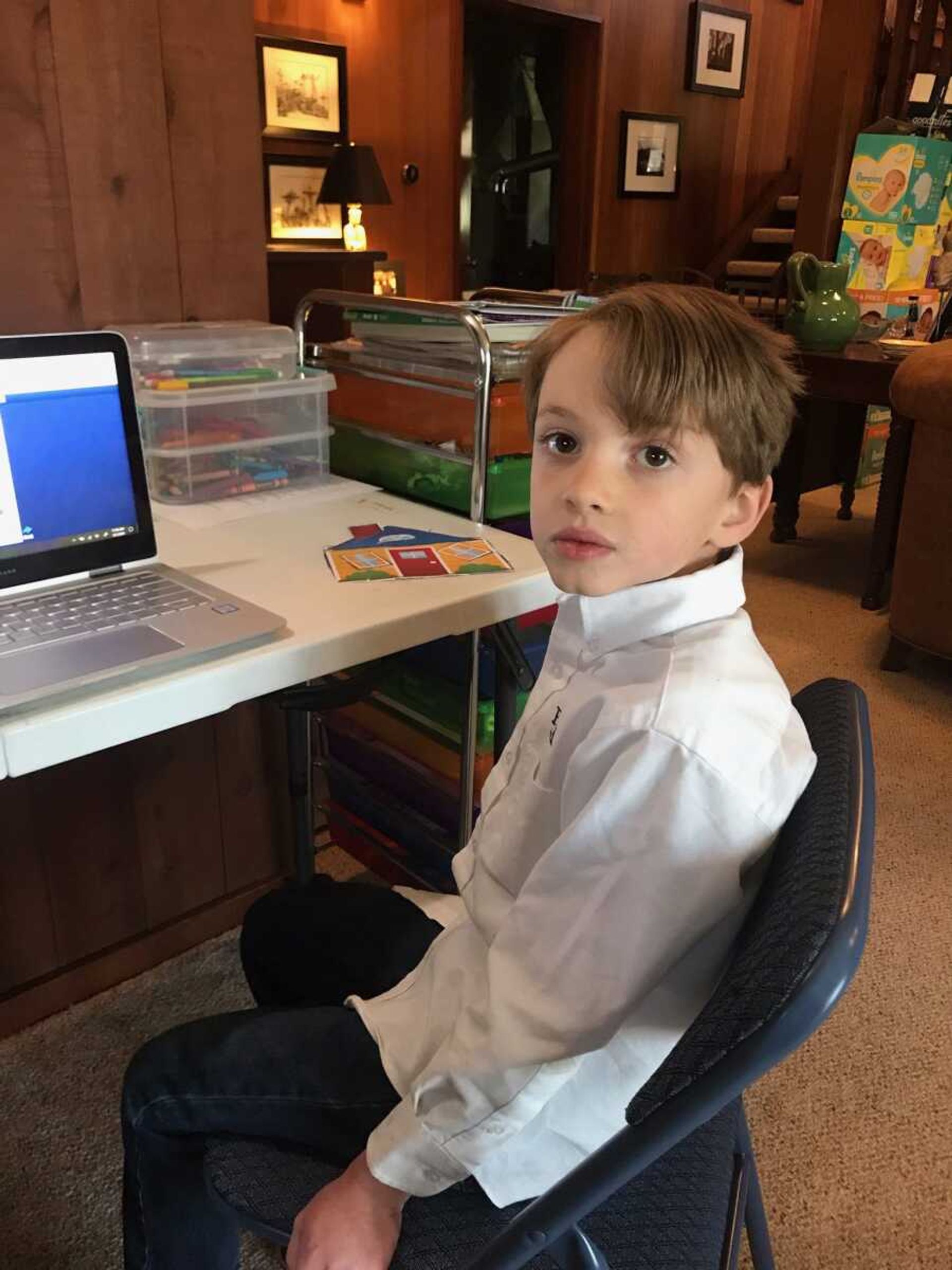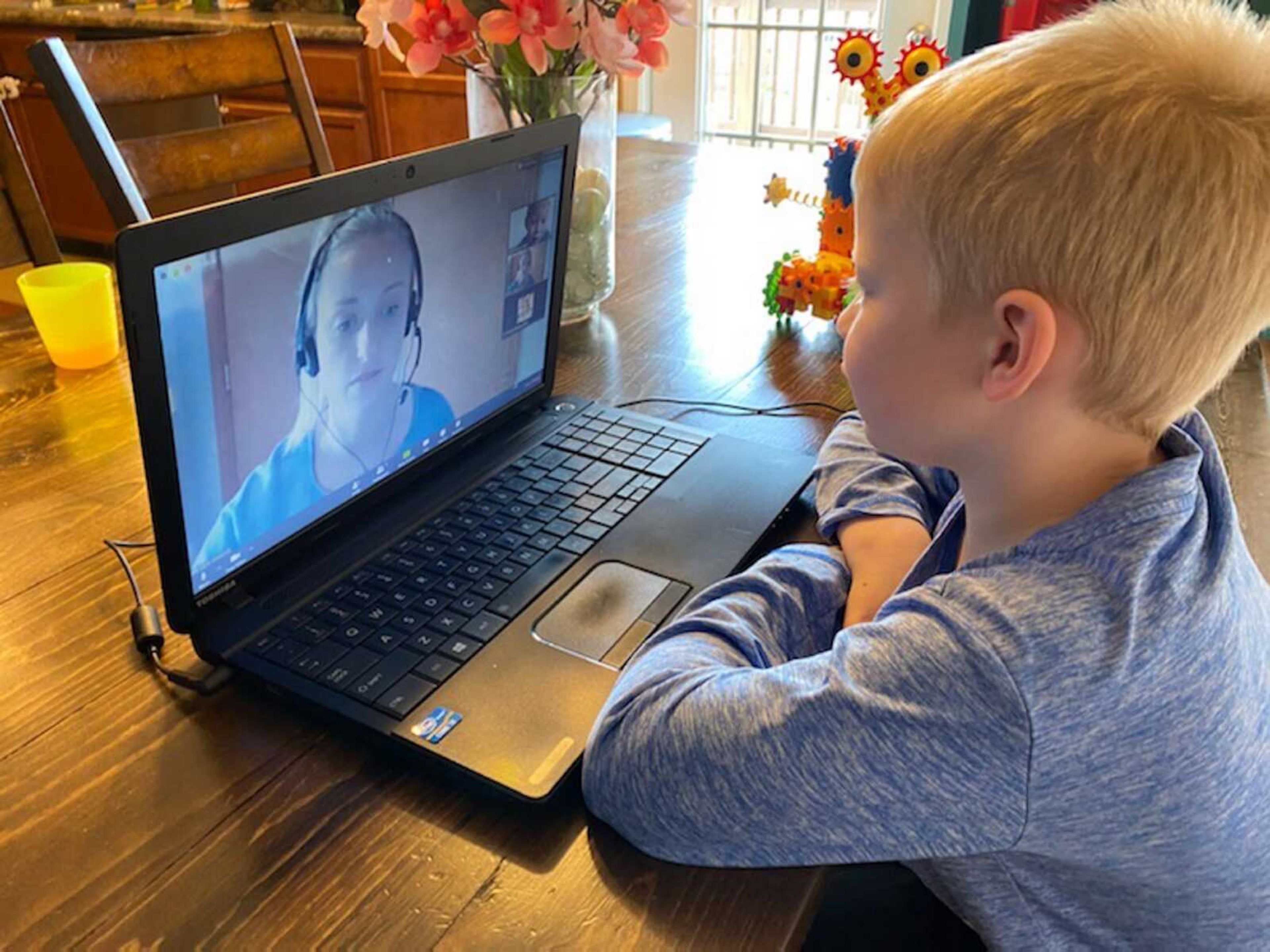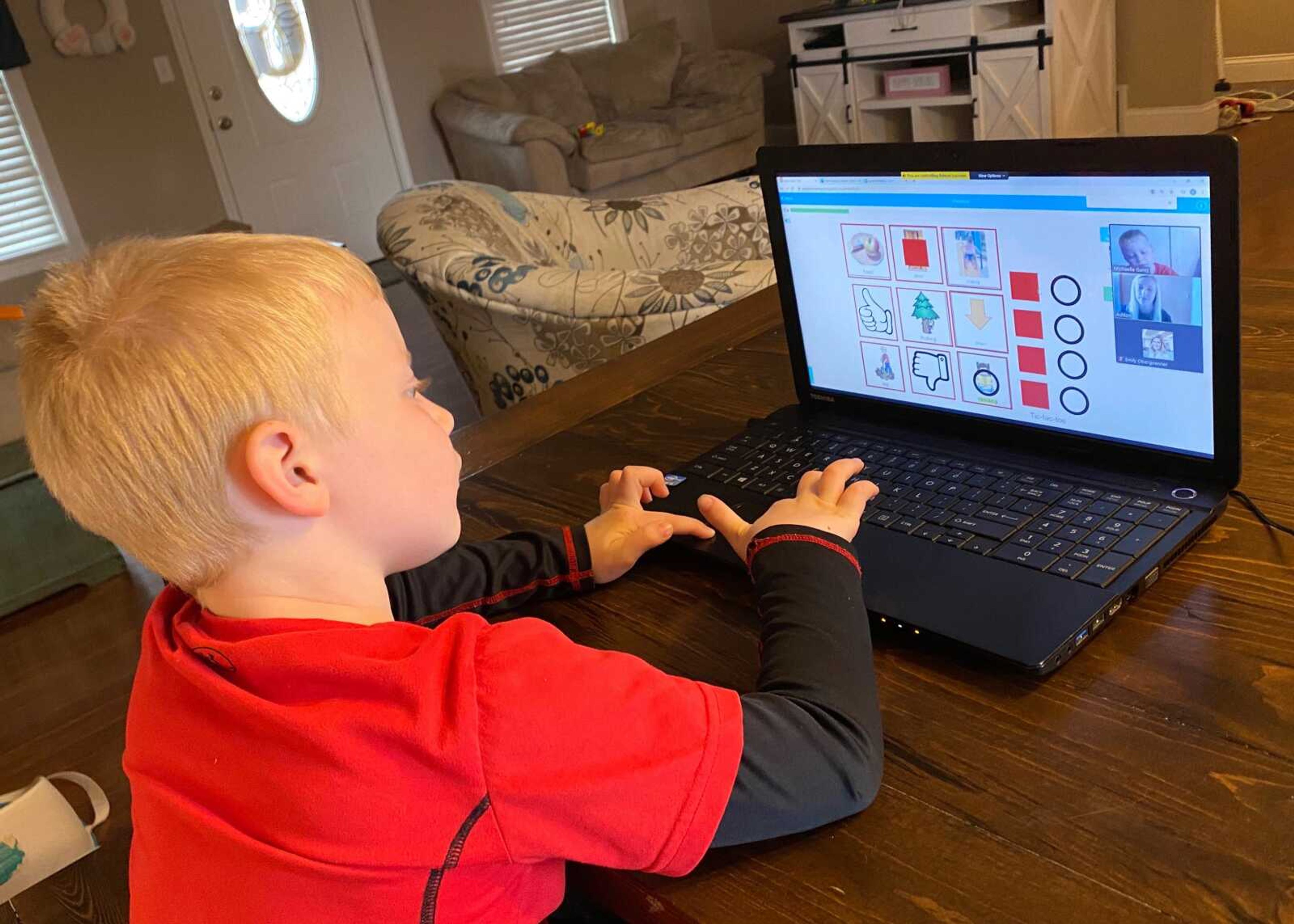Teletherapy provides essential services, innovative learning at Southeast
Twice a week, for 50 minutes at a time, 5-year-old Grayson Gantz is on a video conference call, answering questions, verbally navigating the sounds of certain letters and responding to “boom cards.” While he sounds out parts of speech, an instructor provides crucial feedback and monitors his progress...
Twice a week, for 50 minutes at a time, 5-year-old Grayson Gantz is on a video conference call, answering questions, verbally navigating the sounds of certain letters and responding to “boom cards.” While he sounds out parts of speech, an instructor provides crucial feedback and monitors his progress.
Grayson has these speech therapy sessions — now by video call — with budding speech-language pathologists (SLPs) at Southeast Missouri State University. The student clinicians leading the sessions test the skills they’ve learned through the Center for Speech and Hearing, where Grayson has been a client since the summer of 2018.
The center acts as a training clinic, allowing graduate students — and undergraduates in their final year with the program — to work directly with patients, according to clinic coordinator Amy Herren.
The Department of Communication Disorders has six licensed and certified SLPs on staff, as well as an audiologist, Herren said. The program has 36 graduate students and 17 undergraduates, most of whom need clinical hours to graduate or progress through the master’s program.
While the campus and local community practice social distancing, the Center for Speech and Hearing has adopted telepractice, allowing students to earn clinic hours while patients see little interruption to services.
Communication in a crisis
During Grayson’s session, his mother, Michaella Gantz, sits close by in their Gordonville home to help make sure her Jackson preschooler is actively listening and working through the session.
When the severity of the COVID-19 pandemic began to intensify in the United States, Gantz said she was worried about a possible regression in her son’s speech skills if therapy centers closed. She’s a fourth-grade teacher in the Kelso School District, and while she has many skills to help keep Grayson educated during social isolation, speech therapy isn’t one of them.
“I’ve been very worried about his speech since he was 1,” she said, noting he also works on his speech with a teacher in the Jackson School District. “He has come such a long way just this semester alone. ... I was nervous that if he wasn’t getting anything at all, that he would start regressing.”
Actually, he’s doing pretty well, Gantz said by phone last week.
While it may be just another part of Grayson’s new at-home schedule, teletherapy has become a reality for those with disorders or developmental delays that can impact effective communication.
Townes Bergmann, 7, has had speech therapy for four years and has worked with local professionals, according to his mother, Kyla Bergmann. Townes has autism and attention deficit hyperactivity disorder, known as ADHD, so attentiveness from clinicians and SLPs is even more important, she said. Despite his challenges, Bergmann said her son has done fairly well with teletherapy.

“It’s not the same, of course, with kids on the spectrum, but I sit with him and he’s doing good with it,” she said after his first teletherapy session last week.
Bergmann also fosters three children younger than 23 months, so structured days are important at her Cape Girardeau home. And while teletherapy is part of their routine, Bergmann said it is imperative Townes continues speech therapy multiple times each week.
“If we don’t work on his skills on a daily basis, he becomes frustrated and we get meltdowns and tantrums, like we have to get as many words as we possibly can out of him,” she said. “So practicing is essential.”
Consistent contact and reevaluation of patient progress are particularly important for developing communication skills, according to Missouri First Steps special instructor Terri Stinnett.
“Maintaining consistent contact has allowed progress to continue rather than stagnate,” Stinnett said in a Sunday Facebook message to the Southeast Missourian. “ ... I think we are all concerned with the time it would take to recoup skills if no services were provided. If you look at the rapid development of language in the first three years, you can understand the huge impact that missing services would create for a child [at] that age.”
The ability to communicate is critical, Herren said, especially during a time of crisis.
“Communication needs, they don’t stop in a time of crisis,” Herren said. “ ... If communication is impaired, then it can be very difficult to manage emotions, it can be difficult to ... build relationships and to be able to share with one another.”
People need to be able to express how they’re feeling right now, she continued, noting the ability to continue with speech therapy may offer hope to patients.
“I think being able to access services then helps give people hope that, ‘OK, I can keep working on this, I can keep using tools, I can keep staying connected to my therapist,’” Herren said. “So we can help them problem solve as these communication disorders impact their lives during this time.”
Silver linings
The Center for Speech and Hearing is one of many higher education programs in the United States that have made the switch to virtual services in response to COVID-19. Southeast officials made the decision to move classes online in March, and Friday, university president Carlos Vargas announced this semester’s commencement ceremonies would be postponed until a later date.
Since suspending in-person classes, Southeast has transitioned more than 2,000 sections or courses to online delivery, according to vice provost Doug Koch. And despite it being a “pretty monumental undertaking,” things are going as well as they can, he said.
“The good thing is that SEMO, as with most higher [education] institutions, have had strong online presences for many years,” Koch said, noting the university has had online class options for about 15 years. “A lot of the faculty have taught in those formats already and are familiar with that.”
Despite the sudden adjustments to teaching, learning and clinic services, many impacted by the changes have found silver linings.
For one thing, drive time to and from the clinic has been eliminated, allowing families to access teletherapy more easily, and in some cases, more frequently, according to first-year graduate student Ashton Glascock.

Glascock hails from Ashland, Missouri — where she is waiting out the pandemic and observing social distancing — and works virtually with a clinic family she said has benefited from the switch to telepractice.
“With one of my clients, actually, for the in-person sessions, they could only come once a week because they lived pretty far away,” she said. “And now, they’re able to do two sessions a week, which we think is gonna be really beneficial.”
First-year graduate student Emma Mueller detailed many upsides of teletherapy. Because of the massive switch to telepractice for SLPs across the country, Mueller said new resources have been created that have “tremendously” benefited her service delivery.
Glascock said teletherapy has meant getting creative with session materials, many of which she creates or locates on her own.
“Just like with anything, as I get more comfortable with it and get better at it, it’ll become the new normal,” she said of telepractice. “So it’s just another thing that we can say that we’ve had experience with and maybe some time in our future career endeavors, it’ll be useful and we can use these skills to conduct teletherapy in the future.”
Mueller said she was initially intimidated by teletherapy, noting the supervision requirements set forth by the American Speech-Language-Hearing Association (ASHA) are more intensive for telepractice.
“Our governing body, ASHA, requires that student clinicians be supervised 100% of the time for sessions conducted via telepractice,” she said. “So not only are we being required to do his novel form of therapy to us as novice clinicians, but we are also now being watched under full-time supervision.”
Despite the added pressure, Mueller said the challenge of learning and practicing teletherapy on the fly will only benefit her in the future.
“It has taught me that flexibility in a field such as this is so important,” Mueller said. “I have been encouraged this time, more than ever, to think on my toes. ... So many practicing SLPs across the country are just now being thrown into telepractice without having any ‘real’ experience. I find that I am benefiting significantly from this event because I am getting the experience now as a student.”
Herren said some students in the program are just learning the ins and outs of working with a real client. Along with the face-to-face patient interaction, student clinicians are learning how to conduct therapy, take data, manage behavior and keep up the pace of the session. To adapt those “very new skills” to a completely new method of service delivery is a “pretty big challenge,” she said.
But after the first week of virtual learning and practice, Herren said students are starting to figure it out.
“They’re learning to adapt,” Herren said, noting the program highlights creative, flexible and critical thinking. “Now, they’re getting to really see this in real time. It’s not just me talking about how important it is, but they get to really put these skills to the test.”
The Center for Speech and Hearing is a United Way community partner, Herren said, which has allowed the continuation of services during the pandemic.
“They’ve helped us ... provide services to a larger group of people [and] keep our services affordable,” Herren said. “And so we’re, we’re proud to be able to be a resource for families who otherwise may not have access to speech and language services.”
The Center for Speech and Hearing is still accepting clients and welcomes interested families to visit its website at www.semo.edu/speechandhearing to download a questionnaire. For more information or to send in a completed questionnaire, contact aherren@semo.edu or call (573) 651-2050 to leave a voicemail, which will be returned.
Connect with the Southeast Missourian Newsroom:
For corrections to this story or other insights for the editor, click here. To submit a letter to the editor, click here. To learn about the Southeast Missourian’s AI Policy, click here.










